We are all too familiar with the shortcomings of the Ford 6.0L Power Stroke engine. We talk all the time about its EGR and oil-cooler failures. However, one of the powerplant's lesser-known issues is fuel contamination of the cooling system.
Fuel in the cooling system is typically a result of a crack in one or both of the cylinder heads. These cracks can form in the fuel-injector bores, between the cooling and fuel systems, or near the exhaust valve guides. When this happens, pressurized fuel can enter the cooling system, which then attacks the rubber hoses and O-rings, compromising their integrity. Signs that cracks are present include a swollen degas bottle, spongy hoses, the smell of diesel in the cab, and fuel visibly floating on top of the coolant.
Fortunately, the 6.0L experts at Bullet Proof Diesel have developed a cure that fixes the problem at the source, without requiring removal of the heads. Once located, the cracks are fixed by using a specially designed tool that fits directly into the injector bore and injects a proprietary cylinder head sealant at high pressure. By using this method, there is less downtime, labor, and parts cost involved in the fix. Best of all, for the mechanically inclined enthusiast who would like to tackle the fix, this process can be performed at home, without the need for specialized tools.
The 6.0L Power Stroke is a great engine with a bum reputation. With a little love, these engines will last a long time and make great power doing it. We recently headed out to Mesa, Arizona, to watch as the 6.0L experts at Bullet Proof Diesel walked us through the head repair process.
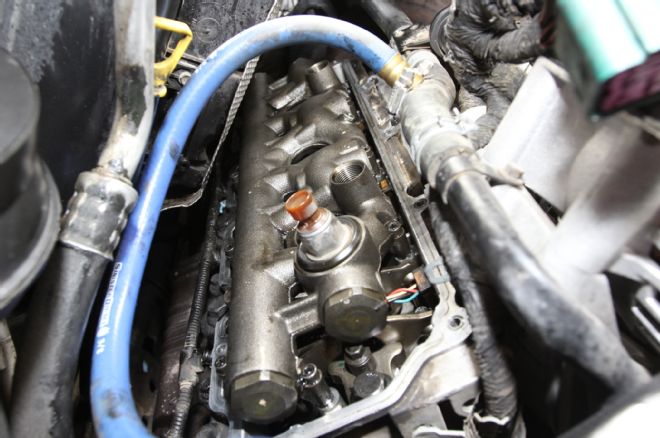
| Ford Power Stroke 6 0L Cylinder Head Repair 02
Fixing a cylinder head crack in the injector bore begins by locating the offending cylinder. The first step in diagnosing a cracked head is to remove the valve covers, exposing the fuel supply rails.
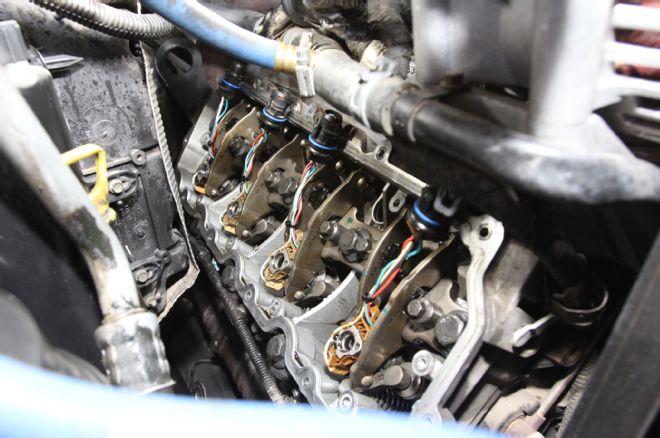
| Ford Power Stroke 6 0L Cylinder Head Repair 03
With the fuel rails removed, technician Delwin Wamsley gets to work, carefully pulling each of the eight injectors. Special attention should be paid to remembering the specific cylinder each injector belongs to.
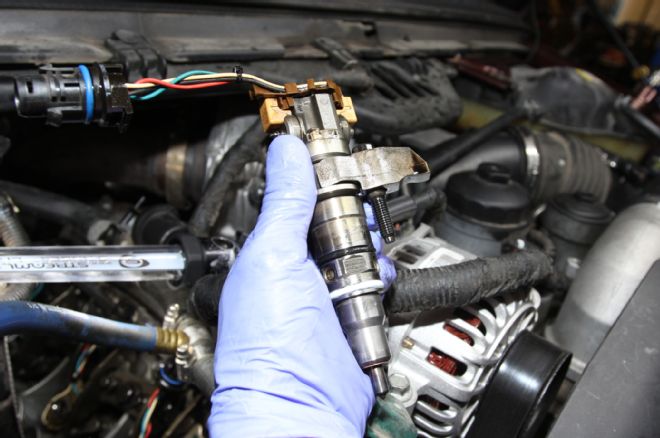
| Ford Power Stroke 6 0L Cylinder Head Repair 04
Each injector is inspected for signs of wear and then placed aside along with its individual holder. A clean working surface is vital to preventing contamination of the fuel injectors.
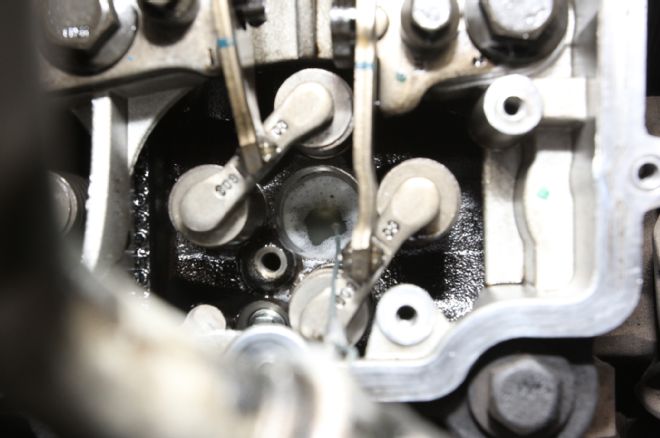
| Ford Power Stroke 6 0L Cylinder Head Repair 05
With all eight injectors removed, rubber stoppers are placed in the injector bores and they are then filled with WD-40. Delwin allows the bubbles to disperse before moving on to the next step.
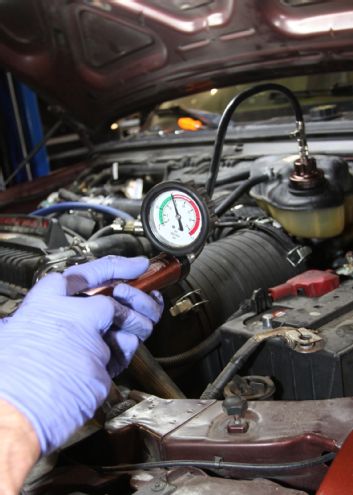
| Ford Power Stroke 6 0L Cylinder Head Repair 06
Once the bubbles in the WD-40 subside, the coolant system is drained and then pressurized to 15 psi using a hand pump and the truck's degas bottle. Finding the offending cylinder is as simple as seeing which injector bores are bubbling from the pressurized cooling system.
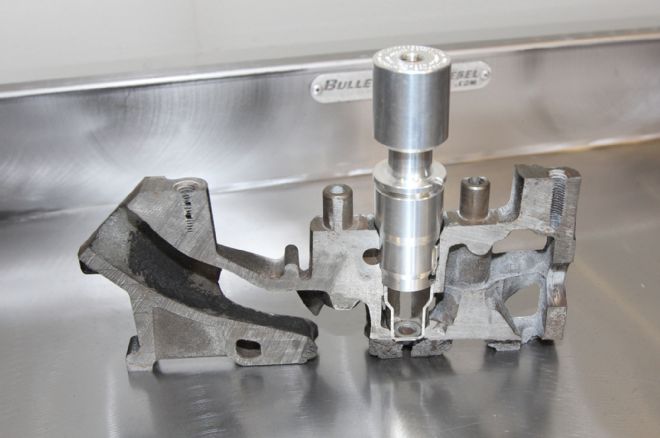
| Ford Power Stroke 6 0L Cylinder Head Repair 07
This cutaway of the 6.0L head shows how the repair tool fits into the injector bore. Cracks typically form between the injector and valve guide (arrow).
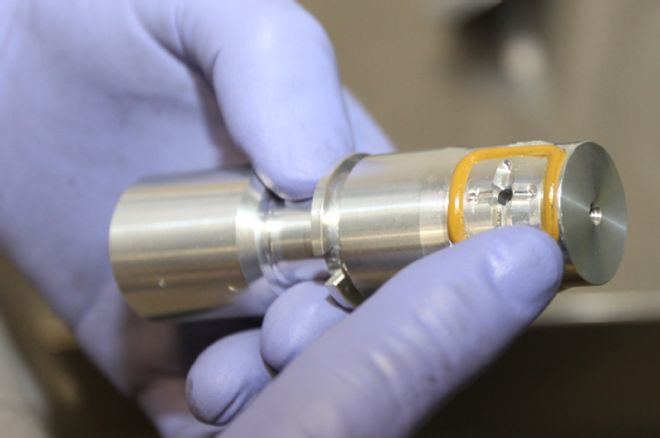
| Ford Power Stroke 6 0L Cylinder Head Repair 08
The O-rings on the machined tool should be lubed with a petroleum-based lubricant before being inserted in the head. Damaging the O-ring can result in a failed fix, and the need to repeat the entire process. It's also a good idea to liberally grease the tool to help prevent it from sticking inside the bore.
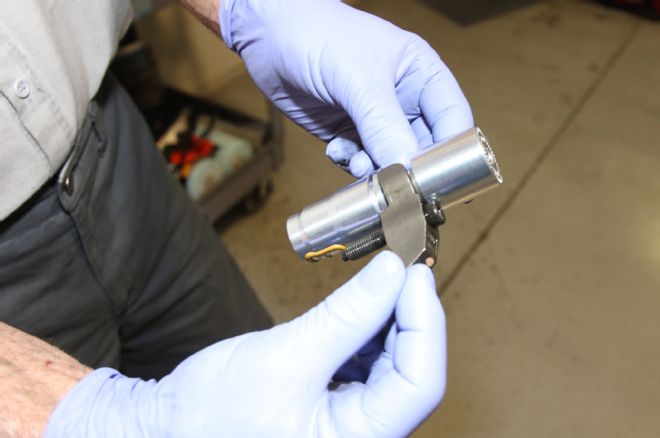
| Ford Power Stroke 6 0L Cylinder Head Repair 09
Using the proper injector retainer for the cylinder that showed symptoms, Delwin inserts the tool and torques the retainer to the proper specifications.
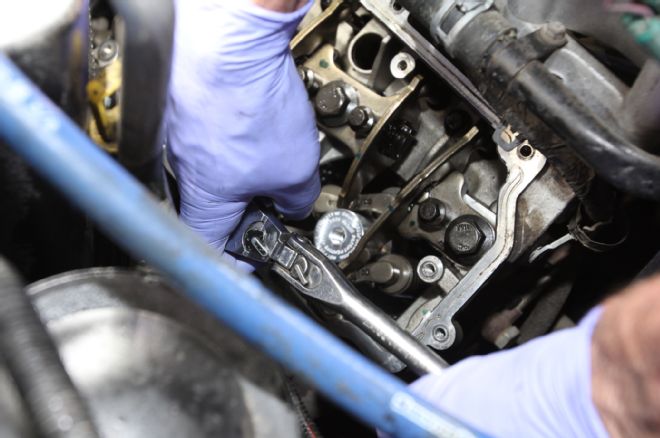
| Ford Power Stroke 6 0L Cylinder Head Repair 10
Overtightening the retainer may cause the tool to get stuck in the bore, which won't damage the cylinder head but will render the tool unusable.
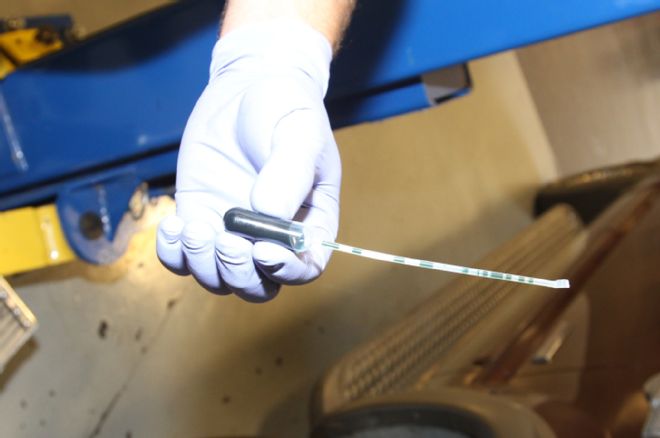
| Ford Power Stroke 6 0L Cylinder Head Repair 11
This is what makes the magic happen. A pipette is filled with the proprietary solution, which is then inserted into the top of the tool.
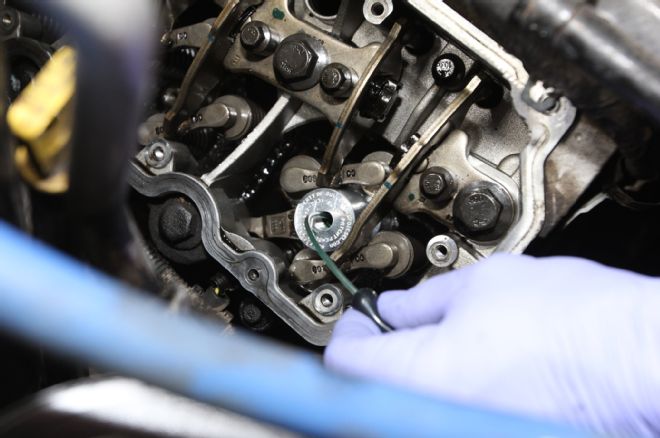
| Ford Power Stroke 6 0L Cylinder Head Repair 12
Once full, a zerk fitting is added to seal the hole and facilitates using a grease gun to apply 500 psi of pressure to force sealant into the cracks.
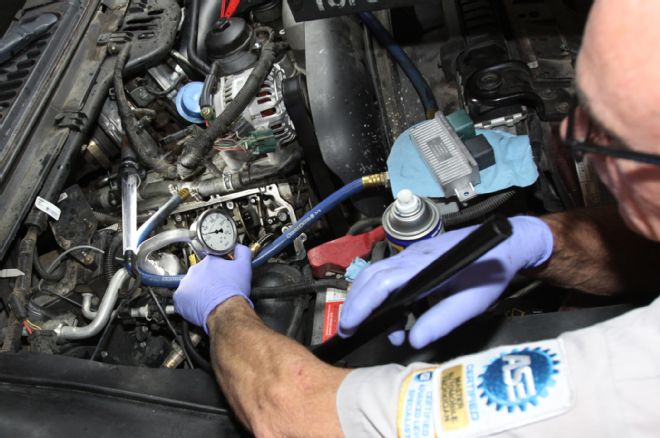
| Ford Power Stroke 6 0L Cylinder Head Repair 13
After the pressurized, solution-filled pipette sits for 10 to 15 minutes, pressure will drop as a result of the sealant making its way into the crack. Once all the cracks are repaired, the truck should be left with the injector bores open for 24 hours to allow the solution to fully cure. If everything checks out after 24 hours, the fuel system is ready to be reassembled and the truck is sent on its way.
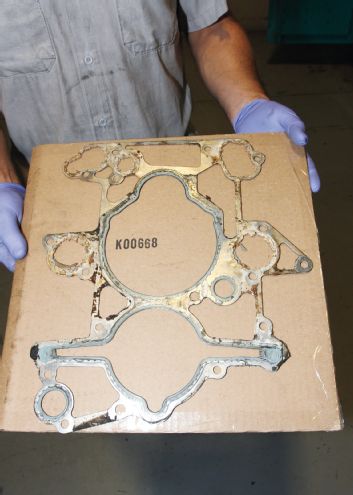
| Ford Power Stroke 6 0L Cylinder Head Repair 14
As an example of the damage fuel in the coolant can cause, Delwin showed us the front cover gasket of another afflicted engine. Note the deterioration that was caused around the coolant passages.
 | Ford Power Stroke 6 0L Cylinder Head Repair 02
Fixing a cylinder head crack in the injector bore begins by locating the offending cylinder. The first step in diagnosing a cracked head is to remove the valve covers, exposing the fuel supply rails.
| Ford Power Stroke 6 0L Cylinder Head Repair 02
Fixing a cylinder head crack in the injector bore begins by locating the offending cylinder. The first step in diagnosing a cracked head is to remove the valve covers, exposing the fuel supply rails.
 | Ford Power Stroke 6 0L Cylinder Head Repair 03
With the fuel rails removed, technician Delwin Wamsley gets to work, carefully pulling each of the eight injectors. Special attention should be paid to remembering the specific cylinder each injector belongs to.
| Ford Power Stroke 6 0L Cylinder Head Repair 03
With the fuel rails removed, technician Delwin Wamsley gets to work, carefully pulling each of the eight injectors. Special attention should be paid to remembering the specific cylinder each injector belongs to.
 | Ford Power Stroke 6 0L Cylinder Head Repair 04
Each injector is inspected for signs of wear and then placed aside along with its individual holder. A clean working surface is vital to preventing contamination of the fuel injectors.
| Ford Power Stroke 6 0L Cylinder Head Repair 04
Each injector is inspected for signs of wear and then placed aside along with its individual holder. A clean working surface is vital to preventing contamination of the fuel injectors.
 | Ford Power Stroke 6 0L Cylinder Head Repair 05
With all eight injectors removed, rubber stoppers are placed in the injector bores and they are then filled with WD-40. Delwin allows the bubbles to disperse before moving on to the next step.
| Ford Power Stroke 6 0L Cylinder Head Repair 05
With all eight injectors removed, rubber stoppers are placed in the injector bores and they are then filled with WD-40. Delwin allows the bubbles to disperse before moving on to the next step.
 | Ford Power Stroke 6 0L Cylinder Head Repair 06
Once the bubbles in the WD-40 subside, the coolant system is drained and then pressurized to 15 psi using a hand pump and the truck's degas bottle. Finding the offending cylinder is as simple as seeing which injector bores are bubbling from the pressurized cooling system.
| Ford Power Stroke 6 0L Cylinder Head Repair 06
Once the bubbles in the WD-40 subside, the coolant system is drained and then pressurized to 15 psi using a hand pump and the truck's degas bottle. Finding the offending cylinder is as simple as seeing which injector bores are bubbling from the pressurized cooling system.
 | Ford Power Stroke 6 0L Cylinder Head Repair 07
This cutaway of the 6.0L head shows how the repair tool fits into the injector bore. Cracks typically form between the injector and valve guide (arrow).
| Ford Power Stroke 6 0L Cylinder Head Repair 07
This cutaway of the 6.0L head shows how the repair tool fits into the injector bore. Cracks typically form between the injector and valve guide (arrow).
 | Ford Power Stroke 6 0L Cylinder Head Repair 08
The O-rings on the machined tool should be lubed with a petroleum-based lubricant before being inserted in the head. Damaging the O-ring can result in a failed fix, and the need to repeat the entire process. It's also a good idea to liberally grease the tool to help prevent it from sticking inside the bore.
| Ford Power Stroke 6 0L Cylinder Head Repair 08
The O-rings on the machined tool should be lubed with a petroleum-based lubricant before being inserted in the head. Damaging the O-ring can result in a failed fix, and the need to repeat the entire process. It's also a good idea to liberally grease the tool to help prevent it from sticking inside the bore.
 | Ford Power Stroke 6 0L Cylinder Head Repair 09
Using the proper injector retainer for the cylinder that showed symptoms, Delwin inserts the tool and torques the retainer to the proper specifications.
| Ford Power Stroke 6 0L Cylinder Head Repair 09
Using the proper injector retainer for the cylinder that showed symptoms, Delwin inserts the tool and torques the retainer to the proper specifications.
 | Ford Power Stroke 6 0L Cylinder Head Repair 10
Overtightening the retainer may cause the tool to get stuck in the bore, which won't damage the cylinder head but will render the tool unusable.
| Ford Power Stroke 6 0L Cylinder Head Repair 10
Overtightening the retainer may cause the tool to get stuck in the bore, which won't damage the cylinder head but will render the tool unusable.
 | Ford Power Stroke 6 0L Cylinder Head Repair 11
This is what makes the magic happen. A pipette is filled with the proprietary solution, which is then inserted into the top of the tool.
| Ford Power Stroke 6 0L Cylinder Head Repair 11
This is what makes the magic happen. A pipette is filled with the proprietary solution, which is then inserted into the top of the tool.
 | Ford Power Stroke 6 0L Cylinder Head Repair 12
Once full, a zerk fitting is added to seal the hole and facilitates using a grease gun to apply 500 psi of pressure to force sealant into the cracks.
| Ford Power Stroke 6 0L Cylinder Head Repair 12
Once full, a zerk fitting is added to seal the hole and facilitates using a grease gun to apply 500 psi of pressure to force sealant into the cracks.
 | Ford Power Stroke 6 0L Cylinder Head Repair 13
After the pressurized, solution-filled pipette sits for 10 to 15 minutes, pressure will drop as a result of the sealant making its way into the crack. Once all the cracks are repaired, the truck should be left with the injector bores open for 24 hours to allow the solution to fully cure. If everything checks out after 24 hours, the fuel system is ready to be reassembled and the truck is sent on its way.
| Ford Power Stroke 6 0L Cylinder Head Repair 13
After the pressurized, solution-filled pipette sits for 10 to 15 minutes, pressure will drop as a result of the sealant making its way into the crack. Once all the cracks are repaired, the truck should be left with the injector bores open for 24 hours to allow the solution to fully cure. If everything checks out after 24 hours, the fuel system is ready to be reassembled and the truck is sent on its way.
 | Ford Power Stroke 6 0L Cylinder Head Repair 14
As an example of the damage fuel in the coolant can cause, Delwin showed us the front cover gasket of another afflicted engine. Note the deterioration that was caused around the coolant passages.
| Ford Power Stroke 6 0L Cylinder Head Repair 14
As an example of the damage fuel in the coolant can cause, Delwin showed us the front cover gasket of another afflicted engine. Note the deterioration that was caused around the coolant passages.